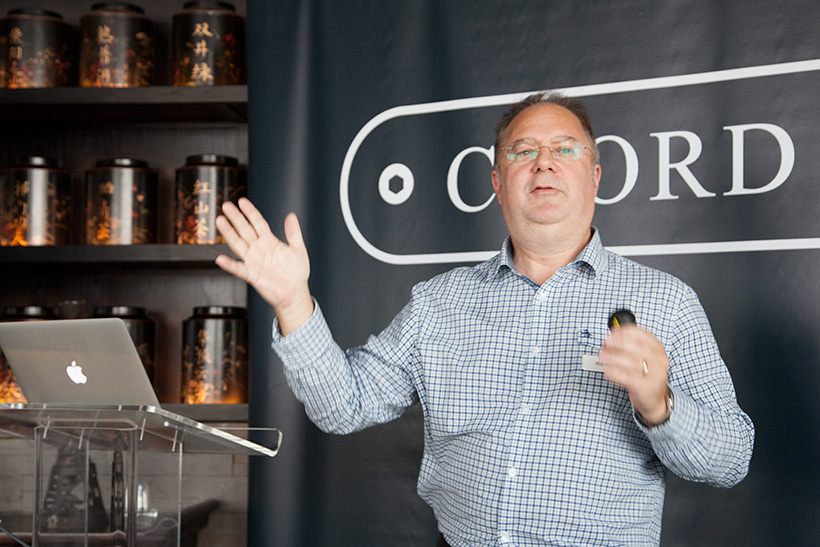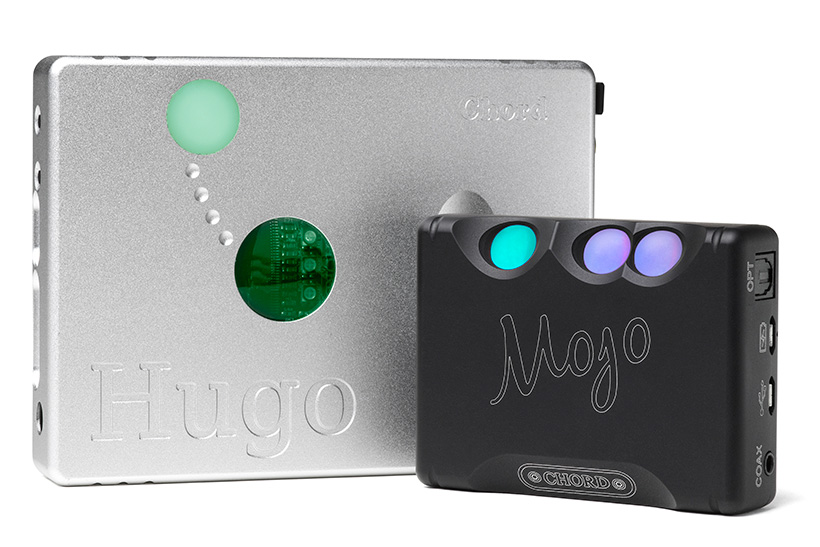We talk to Rob Watts about the digital engineering behind Chord Electronics remarkable Mojo portable DAC. Rob explains just what ‘taps’ are and why they matter, and there’s a lot more to it than digital audio technology.
Jason Kennedy: You like to talk about taps in DAC chips, the more the RW: merrier seems to be the gist, but what are they and why does no one else mention them?
Rob Watts: OK, the interpolation filter’s job in a DAC is to re- create the missing parts of the original analogue signal – the signal in between one sample and the next. This is done with an FIR filter. In a simple way, a FIR filter consists of a data memory (this stores previous data samples) and a coefficient memory (this is a fixed memory with all of the coefficients that the filter algorithm has created). To create an intermediate data, you simply multiply and add all of the stored data samples with a particular coefficient, and once you have added all of the values you end up with the intermediate value you need. Now in the early days, you used a delay line to store the previous data samples, and you tapped into this delay line in order to access the stored data. Hence the word taps.
So why is it only me that goes on about taps and stuff? The problem is about understanding – when I was at university, I studied electronics. But I was passionate about audio, and was interested in the physiology of hearing. I thought if I understood that, I could make better audio electronics. One of the things I was very interested in was how the brain processed the output from the ears. Now we take our hearing for granted, but the brain does some amazing things to give us auditory perception – separating individual sounds into separate entities with placement data (where are sounds located) is an amazing feat, requiring considerable processing. And we know very little as to how the brain does this. Anyway, what I did learn was that transients were a very important perceptual cue, and that the timing of transients was crucial. From transients the ear brain locates sounds in space, it is also used to compute pitch (particularly for bass) and it’s used for getting the timbre of an instrument. I spent a lot of time researching this in the psychology library, which was close to my hall of residence. Anyway, one of the courses in electronics was Whittaker Shannon sampling theory. And this is the basis of digital audio. From this it is a fact that if you had an infinite tap length FIR filter you would perfectly reconstruct the original bandwidth limited analogue signal in the ADC. It would make no difference if it was sampled at 22uS or 22pS you would have the same digital signal. But it was very clear to me that having a limited tap length would create timing errors. And I know from my studies and from my own listening tests that that would be a major subjective problem.

Rob Watts at the Chord Mojo launch
Now, unfortunately, nobody else has recognised this problem for two reasons. One is electronic engineers do not study hearing, and the second problem is that they are stuck on the idea that filters are a frequency domain problem and not a time domain problem. So if you design a filter where your only concern is frequency, then a 100 taps or so is enough. But if you think from the timing perspective, it categorically is not enough. What I have done is to make no assumptions about whether something makes a difference to the sound unless I actually do a listening test. And listening to increasing tap lengths always improves the sound quality. With Dave, I am at 164,000 taps, and I know that that is not the end of it and that further improvements are possible.
Is an FPGA a DAC chip that the designer can customise rather than a fixed set of parameters as found in regular converter chips?
No an FPGA is not a DAC chip, it’s a sea of gates that you can connect together to make any digital device you like. You could make a PC processor out of an FPGA, or a device that controls a rover on Mars, or the digital parts of a DAC. I also create IP and designs for audio to make silicon chips. And my designs could be used to make a dedicated DAC chip, or it could be used to program an FPGA. The benefits you have using an FPGA are considerable, as you can have thousands of times more processing power than is found inside high end audio silicon chips. Indeed, Mojo has 500 times more processing power than conventional high performance DACs.
Is there a separate analogue output stage in Mojo or is that derived directly from the FPGA?
Absolutely. An FPGA is entirely digital and cannot have analogue outputs. This is done with discrete components (flip flops, resistors, capacitors and separate reference circuitry). Doing the analogue discretely has big benefits. In designing silicon DACs there are enormous problems – the clock has to be distributed, and this increases jitter, the substrate injects noise and distortion into the analogue parts, the reference circuitry can't have low enough impedance and is noisy, resistors are non-linear, capacitors are non-linear too. None of these problems apply with discrete DACs.
So does this mean anybody can design their own DAC's using FPGAs? No I am afraid not. Creating the internal modules, getting them right, getting the DAC technology right, has taken me 30 years to do. This is not easy to do.

Hugo and Mojo, guess which has the most advanced tech inside.
I am getting rather different sound from coax and USB inputs with the latter sounding better, what’s the reason for this?
It’s complicated and depends upon a number of factors – principally the amount of RF noise injected into the Mojo, and the amount of correlated noise that gets in. It will depend upon the source device as to which sounds best. My preference is optical, as this has the smoothest sound quality and best depth, as it does not suffer from both of the aforementioned problems.
Does Mojo upsample and if so what does it upsample up to?
Yes all my DAC's up-sample to 2048 times that is at least 16 times more than typical. What does this do? Well its not just about up- sampling but filtering out the RF noise that is present on a digital signal. Its essential to do this, as it gets you closer to the original analogue signal in the ADC (and this is the DAC's job to recover the analogue signal not the digital data). This extensive filtering reduces jitter sensitivity by a factor of 64, and allows the DAC to eliminate noise floor modulation. Now this is a very important problem, as it makes the DAC sound hard and less smooth and is a major problem with DACs – all other DACs have very large noise floor modulation, Mojo has zero measurable noise floor modulation (I have plots at home proving this). This is a major reason why Mojo sounds so smooth and natural.
How low a headphone sensitivity can Mojo sensibly drive?
I wanted Mojo to work with the most sensitive IEMs available, and to do that I had to improve noise. That's why Mojo has a 125 dB dynamic range. To do this was not easy, but it means that you can drive any headphone on the market as Mojo has extremely low noise, but is able to deliver over 5v RMS and 0.5A RMS of current.
You say you tuned the Mojo to have a smoother sound, was this in order to make it more forgiving of real world formats like MP3?
Yes I wanted it smoother and warmer, not so much with AAC or MP3, but more because it is likely to be partnered with harder sounding headphones.


